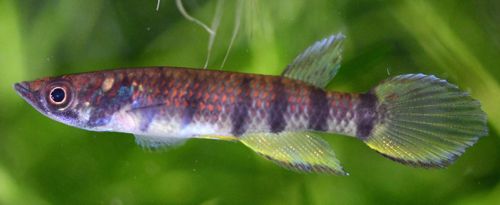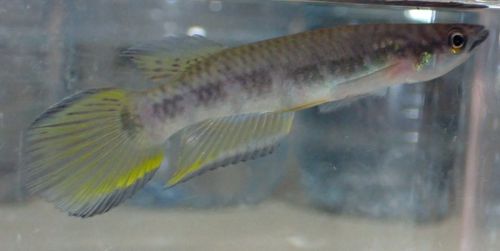Epiplatys infrafasciatus infrafasciatus (Günther 1866)

Wild fish from import into the UK December
2022
Photo courtesy of William King
| Meaning of Name |
Refers to the stripes on the body. |
| First Description |
Günther A. 1866. Catalogue of the fishes in the British Museum. Volume 6, p 313. |
| Size |
8 cm (Radda 1979) |
| Meristics |
|
| Karyotype |
n = 24, A = 25 (Scheel 1968, 1974, 1990) |
| Sub-Genus |
|
| Group |
sexfasciatus |
| Synonyms |
|
|
Populations
|
CMG 23 / 1 - N3 17km N Edéa Limbe Mile 11 - Collected by Olivier Buisson 1999. Ngot - Collected by Armbruster et al in
the 1980's.
|
| Type Locality |
The original description gives 'West Africa; Upper Nile' as the type locality. The 'West Africa' location according to a note from Günther originated from Old Calabar (present day Calabar). Wildekamp in 'A World of Killies' Vol III gives a grid reference of 08° 20'E; 04° 57'N. The Upper Nile location is Epiplatys spilargyreius. |
| Distribution |
Widely distributed from the east bank of the Cross River in southeastern Nigeria into the coastal plain of Cameroon & into the northern half of Equatorial Guinea. They are also found on the island of Fernando Poo. |
| Habitat |
Coastal rainforest streams, brooks & swampy areas. |
| Distinguishing Characteristics |
Has been confused with E.infrafasciatus zenkeri. E.inf.infrafasciatus has a dark marginal outer margin in the anal fin with a bright yellow submarginal band. E.inf.zenkeri has a solid orange anal fin. |
| Colour/Pattern Variability | Fairly high |
| History |
Günther described this species in 1866 from a single male collected in Old Calabar, southern Nigeria & a single male from the Upper Nile. In 1895 Garman put infrafasciatus & sexfasciatus as synonyms for spilargyreius. Keilhack, in 1910, & Boulenger, in 1915, considered these to be a synonym of sexfasciatus. Keilhack also placed the collection from the Nile drainage as marnoi (later regarded as a synonym for spilargyreius). In 1895 Lönnberg considered infrafasciatus to represent a distinct species & referred to a specimen collected from the Ndian River. Also referred were 3 specimens from Sanye (Sunyi), Cameroon. Scheel considered these to be sexfasciatus. Again in 1895, Steindachner referred 4 specimens collected in Liberia as infrafasciatus. Scheel considered these to represent fasciolatus. Boulenger reported a collection from Sapelle, Niger Delta in 1901. Günther, in 1902, reported a collection from the Bokitsa Mine, Ghana & the Atesu River which were referred to infrafasciatus. Scheel examined these preserved fish & found them to be chaperi except for one individual from the Bokitsa Mine which he considered represented Archiaphyosemion petersi. In 1970 Radda described E.sexfasciatus rathkei from near Lake Kumba, western Cameroon. This form was reported to grow to 15 cm. In 1975 Berkenkamp described E.sexfasciatus baroi. The type specimens were collected in a small stream near Kribi, Cameroon. Distributed to BKA breeders team members as 'rathkei'
in October 1973. |
| Breeding Notes |
I found this an easy species to breed although some populations are regarded as more difficult. I could find no information as to which populations are regarded as difficult but I would suspect they would be from locations in Cameroon. They are mop spawners, laying on top or bottom mops. Eggs are best collected & stored in a seperate container either in water or on wet peat. Water incubation takes 10-16 days. You can leave eggs on peat for 4 weeks+ before wetting. Raising fry presents no problems. Sexual maturity is attained at about 5-6 months but to reach full size they require up to about 12 months. German breeders found that the rathkei &
baroi forms would breed in the rainy season which had poor light conditions.
Winfried Stenglein in BKA Newsletter No. 297 (June 1990) reported the
populations from Makondou & Mbebe would spawn in unlit tanks of
22° C (about 10 - 15 eggs daily). He reported many eastern collections
spawn best when half full size - older fish tended to be less active. |
| Diameter of Egg | |
| Remarks |
This species has been split by some authors into subspecies E.infrafasciatus infrafasciatus; E.infrafasciatus baroi; E.infrafasciatus rathkei. However, baroi & rathkei were described mainly on colouration differences which is not regarded as strong enough evidence to support giving certain populations subspecific status. |
